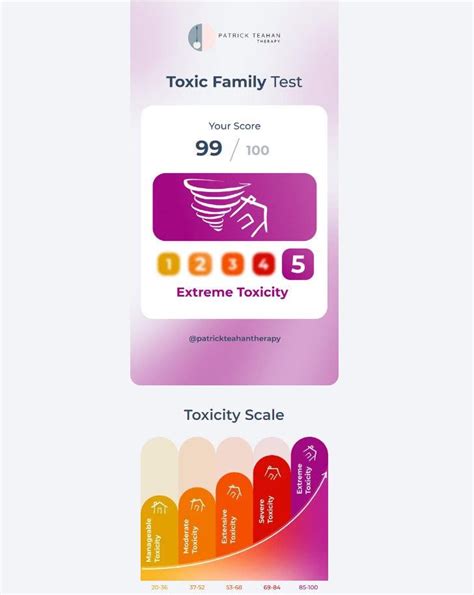Introduction

Toxic family dynamics can have a profound impact on an individual’s mental, physical, and emotional well-being. Developed by renowned family therapist Patrick Teahan, the Toxic Family Test is a comprehensive assessment tool designed to evaluate the health of your family system. By answering a series of questions about your family relationships, you can gain insights into the strengths and weaknesses of your family and identify areas for improvement.
What is the Patrick Teahan Toxic Family Test?
The Patrick Teahan Toxic Family Test is a self-assessment tool that consists of 20 questions. Each question explores various aspects of family functioning, such as communication, boundaries, conflict resolution, and support. Respondents rate their level of agreement with each statement on a scale from 1 (strongly disagree) to 5 (strongly agree).
How to Take the Test
The Toxic Family Test can be easily taken online or through a mental health professional. Here are the steps to complete the test:
- Gather your materials: You will need a pen, paper, or a computer with internet access.
- Read the instructions carefully: Make sure you understand the purpose of the test and the instructions for completing it.
- Answer the questions honestly: Answer each question based on your experiences and observations of your family dynamics.
- Score your results: Sum up your scores for each question. Higher scores indicate a greater presence of toxic family dynamics.
Interpreting Your Results
The Toxic Family Test results are categorized into three levels:
- Healthy Family: Scores below 40 indicate a healthy family system with strong communication, boundaries, and support.
- Dysfunctional Family: Scores between 40 and 60 suggest moderate levels of toxicity. Families may exhibit communication barriers, unclear boundaries, and conflicts.
- Toxic Family: Scores above 60 indicate a toxic family system with severe dysfunction. Families may experience emotional abuse, neglect, and poor communication.
Benefits of the Toxic Family Test
The Toxic Family Test offers numerous benefits for individuals seeking to improve their family relationships:
- Increased self-awareness: The test provides insights into your family’s strengths and weaknesses, allowing you to identify areas for growth.
- Enhanced communication: By recognizing patterns of communication and conflict resolution, you can work towards improving communication within your family.
- Improved coping strategies: The test helps you identify triggers and develop coping mechanisms for dealing with toxic family dynamics.
- Informed decision-making: The results can assist you in making informed decisions about your relationship with your family, such as setting boundaries or seeking external support.
Tips for Improving Family Dynamics
If you have identified toxic patterns within your family, there are steps you can take to improve the situation:
- Communicate openly and honestly: Share your feelings and concerns with your family members in a respectful and assertive manner.
- Set clear boundaries: Define your limits and expectations to prevent others from violating your well-being.
- Practice active listening: Pay attention to what others are saying without interrupting or dismissing their perspectives.
- Seek professional help: Consider family therapy or counseling to facilitate a healthier family system.
Frequently Asked Questions
1. Is the Toxic Family Test a reliable and valid measure?
Yes, the Toxic Family Test has been validated through research studies and demonstrates good reliability and validity.
2. Can I retake the test over time?
Yes, it is beneficial to retake the Toxic Family Test periodically to track progress and identify changes in family dynamics.
3. What if I score in the toxic family range?
A score in the toxic family range indicates a need for immediate attention. Consider seeking professional support and implementing strategies to address the dysfunction within your family.
4. How can I improve the communication within my family?
Encourage open and honest communication, practice active listening, and avoid interrupting or dismissing others’ perspectives.
5. What are some signs of a healthy family system?
Healthy families exhibit strong communication, clear boundaries, mutual support, and respectful conflict resolution.
6. Can toxic family dynamics change over time?
Yes, with effort and commitment, toxic family dynamics can be improved through therapy, communication, and boundary setting.
7. What are some resources for getting help with toxic family dynamics?
Family therapists, mental health professionals, and support groups can provide guidance and assistance in navigating toxic family relationships.
8. Is it possible to have a healthy relationship with a toxic family member?
Yes, it is possible to establish healthy boundaries and maintain a limited relationship with a toxic family member while prioritizing your own well-being.
Conclusion
The Patrick Teahan Toxic Family Test is a valuable tool for assessing the health of your family relationships. By understanding the dynamics within your family, you can take proactive steps to improve communication, set boundaries, and promote a more positive and supportive family environment. Remember, you are not alone, and there is help available to address toxic family dynamics.
